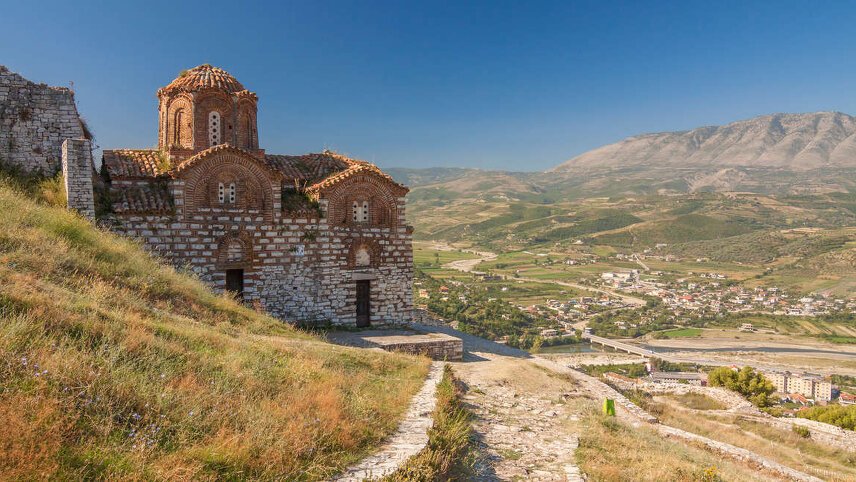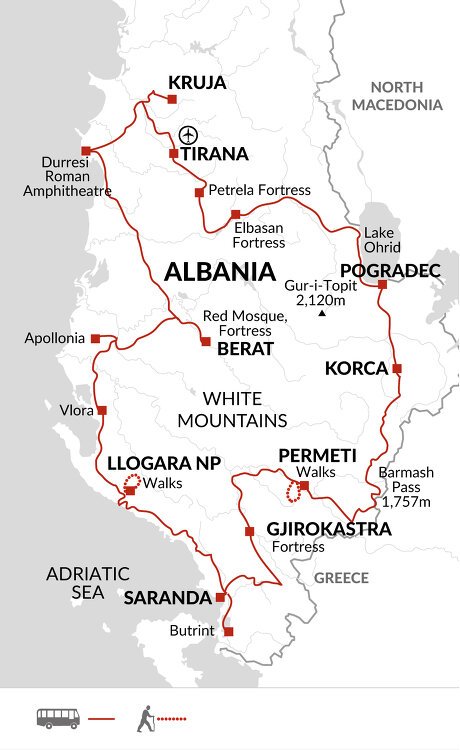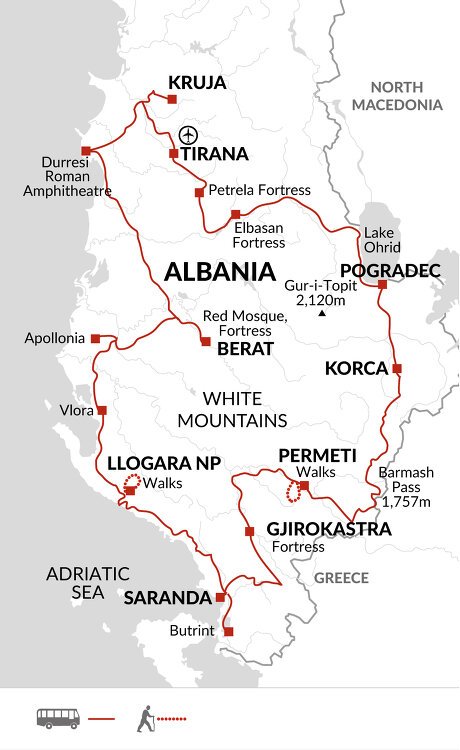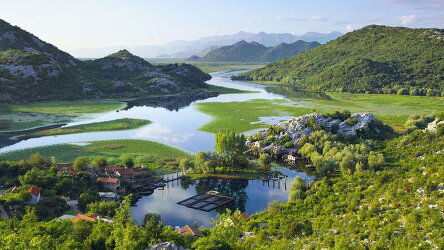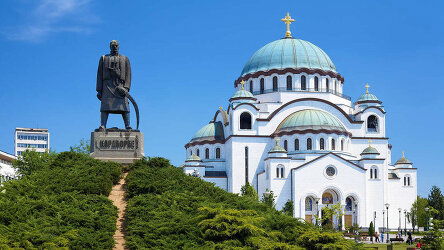Overview
Itinerary
Arrive in Tirana, Albania's colourful capital city. With a blend of communist architecture and a backdrop of rugged mountains, Tirana is a mix of new and old.
For those arriving on time our Tour Leader plans to meet you in the hotel reception at 6pm for the welcome meeting and for those that wish, there is the chance to go out for dinner. There are no other activities planned today, so you are free to arrive in Tirana at any time. If you would like to receive a complimentary airport transfer today, you'll need to arrive into Tirana International Airport (TIA), which is about 30 minutes' drive. Should you miss the welcome meeting, your Tour Leader will inform you of any essential information on the morning of day two.
If your flight arrives earlier in the day, perhaps you might choose to head out to explore the city which is easy to navigate on foot. The National Museum with its easily recognisable mosaic frontage, is well worth a visit to learn about the fascinating history of Albania. If you're into markets, check out Pazari i Ri, an open-air market where you can buy everything from fresh produce to local specialties such as byreks, baklavas and honey.
Whilst in Albania we'll have the opportunity to sample the delicious cuisine, which is a real mix of Turkish, Greek and Italian influences, like byrek - a spinach and feta stuffed filo pie, and in the more rural mountainous areas barbequed lamb and 'earthy' vegetables such as griddled aubergines and mushrooms are particularly popular. Along the coast, there will be the chance to sample fresh seafood. Albanian red wine is especially good and also local beers, such as Birra Korca.
On this trip, we have packed in as many highlights of Tirana as we can, but there is very little free time in the city, so if you wish to spend some time discovering more on your own, we recommend extending your stay for a night or two. Stay: Hotel Vila Tafaj (Comfortable)
This morning, we drive a short distance to the outskirts of Tirana and visit Bunk Art 1, a huge nuclear bunker that was intended as a shelter for dictator Enver Hoxha and the innermost circle of his government. Just arriving at the bunker is quite an exciting experience, as you go through a long, dark tunnel in the hillside that leads you to the entrance on the side of a still-active Albanian military base. Once you're inside the bunker itself, you can wander through the furnished rooms intended for the communist elite as they faced the invasion that so terrified them.
After the visit, we jump on the Dajti Express cable car, which is the longest cableway in the Balkans. Our 15-minute journey takes us almost to the top of Mount Dajti at around 1,049 metres. From here, we admire the views over the city below and the surrounding highlands.
From Mount Dajti, we continue our drive to the Pellumbus Guesthouse where we will meet the Duqi family. They have transformed their home into a guesthouse welcoming visitors from around the world. Lunch will be served in their garden, and we will have the opportunity to try tasty local produce such as cheeses, jams, fruits and olive oils.
We then drive back to Tirana for a walking tour of the city to see the main sights including the government buildings, Skanderbeg Square, the old bazaar and Et'Hem Bey Mosque. Stay: Hotel Vila Tafaj (Comfortable) (B/L)
This morning before leaving Tirana we will visit the Bektashi World Centre. The Bektashi Order is an Islamic dervish sect who blends elements of both Shia and Sufi beliefs. We'll have a brief stop to see their ornately decorated tekke (place of worship) with its marble mosaics.
We then drive two-and-a-half hours to Elbasan to visit the historic fortress before continuing to the picturesque fisherman's village of Lin where we will have free time for lunch before we drive to Pogradec, on the shores of Lake Ohrid. The lake is one of the oldest in the world and is a spot renowned for its natural beauty. During the summer months, you might want to take a refreshing swim in the lake before dinner. Stay: Enkelana Hotel (Comfortable) (B)
Today, we make the journey to Voskopoja - formally known as Moskopoje. Founded in the 16th century, the town was once a major urban settlement and was famous for its churches which were adorned with many beautiful frescoes. After exploring the churches, we will have lunch in one of the local restaurants and try some of the local specialities.
We then continue to Korca, sitting at the foot of Moravia Mountain, where we will spend the night.
On arrival, we take a city tour including the Resurrection Cathedral, which is the main Orthodox Church.
In the evening, there is the change to go to the old town and try the famous 'Baked Raki' (Raki e pjekur). A raki tasting provides a delightful opportunity to appreciate and discover the rich tradition of Albanian spirits. Local establishment invites visitors to sample a variety of raki flavors while enjoying the cozy ambiance of this historic city. Stay: Hotel Grand Palace (Comfortable) (B)
Our journey today takes us through the southern highlands to Gjirokaster. Travelling along one of the most scenic routes in Albania, we will reach the Barmash Pass (1,040 metres) where we can enjoy sweeping views of the Nemercka Mountains, which are snow covered for most of the year and form the border with Greece.
For lunch, we will stop in a mountainside restaurant serving homemade raki or if it is too early for you, try the mountain tea, one of the most popular herbal teas in Albania.
We continue our drive to Gjirokaster with a stop at Benja to admire the stunning view of the Ottoman stone bridge over the river with the mountains in the distance. There, enjoy a dip in the warming waters of the thermal pools, born from the geothermal waters near Permet. The heated water flows down the river unless it gets diverted into one of the several human-made pools. Some say the baths have healing properties. The rest of the drive to Gjirokaster takes us through the White Mountains via Kelcyra Gorge, carved by the Vjosa River on its way to the Adriatic Sea. The scenery in the mountains is breathtaking with rolling valleys, that in spring are covered with some of the most exuberant wildflowers you are likely to see anywhere in Albania.
We will spend the next two nights in Gjirokaster, often referred to as 'the pearl of Albania' and undoubtedly one of the most beautiful and enchanting towns on the Balkan Peninsula. Stay: Hotel Cajupi (Comfortable) (B)
This morning, we visit The Ethnographical Museum in the historic district of Palorto where the dictator Enver Hoxha was born. Set over four floors it offers us an insight into the traditional affluent Albanian lifestyle of the town with numerous household items, folk costumes, and cultural artefacts on display.
We then drive to Dhkosat village for a traditional homemade lunch at a family house. We meet the family and explore their farm where we will learn about the rural life in Albania. Depending on the season, discover the beehive and taste their local honey, walk around the vineyard, and learn about the local wine production or visit the padlocks to meet the goats and other animals on the farm.
Later, we return to Gjirokaster where we take a walking tour through the cobbled streets of its UNESCO-listed historic centre and visit Gjirokastra Castle. The castle sits at a height of 336 metres and is one of the most magnificent structures in the city with views over the hilly countryside, river valley and city. There have been extensive renovations to the building since it was constructed in the 12th century and it now possesses five towers, a church, a cistern, and houses the Weapons Museum. The museum exhibits captured artillery and memorabilia of the Communist resistance against German occupation, as well as a captured US Air Force plane to commemorate the Communist regime's struggle against the 'imperialist' western powers. Stay: Hotel Cajupi (Comfortable) (B/L)
Leaving Gjirokaster behind us, we drive two-and-a-half hours to Saranda. Along the way, we will stop and walk to the karstic spring, known as 'The Blue Eye' where we can marvel at the blue clear waters.
This afternoon, we visit UNESCO listed Butrint, which is one of the great archaeological sites in the Balkans. With a long and colourful history dating back to the early Neolithic age, Butrint has been occupied and fought over until the Ottoman period when it lay abandoned. More recently, excavations have taken place and all periods of Butrint's history have been revealed including its Roman theatre, Roman house and thermal baths as well as a fine baptistery with fabulous mosaic floors. The setting is idyllic with the ruins nestling in the bend of the Vivari River.
After spending time exploring this fascinating site, we return to the shores of the Mediterranean and Saranda for the night. Stay: Hotel Iliria (Comfortable) (B)
As we leave Saranda, we can look forward to another scenic coastal drive (three hours) along the Albanian Riviera, before winding over the 1,000-metre-high pass at Llogora as we travel to the national park, which goes by the same name. Along our route we pass terraces planted with citrus groves and olive trees and enjoy the views over the mountains, sea and forest.
We stop at Ali Pasha Fortress, a castle on a small peninsula within Palermo Bay with stunning views over the turquoise coastal waters. Although small, the walls of the triangular fort are well preserved, along with some cannons found here. We'll stop for lunch along the beach at Himara and for a well needed refreshing swim in the clear waters during the summer months.
Upon reaching Llogora National Park, we will have time for an optional hike in the mountains with many attractive views along the way. Tonight, we'll stay at hotel nestled amongst the pine trees of this tranquil national park. Stay: Hotel Alpin (Comfortable) (B)
This morning, en route to Apollonia. we stop at Vlora where we visit Flag Square and the Muradi Mosque.
From here, we continue our drive to Apollonia. Founded in 585 BC and dedicated to the god Apollo, the city achieved fame and wealth before being incorporated into the Roman Empire to become Caesar's stronghold during the civil war with Pompey. The most impressive feature of the site is the bouleuterion - a facade with six Corinthian columns which are thought to date back to the 2nd century AD. Although much of the ancient site is yet to be excavated, with so few other visitors, it is possible to imagine a time when the site supported 55,000 men and Octavian (later to become Emperor Augustus) was one of its students. We continue our drive to Berat where we spend the night. Stay: Hotel Mangalemi (Comfortable) (B)
Situated over a gorge next to the Osumi River and in the shadow of Mount Tomori, Berat's white buildings sprawl up the hillside towards the fortress. New construction is strictly regulated in order to maintain the city's unique character in its UNESCO listed historical centre. Exploring on foot this morning, we head up to the fortress and see the painted icons and frescoes in the Church of Saint Mary, one of the seven churches within the citadel walls. We will also visit the oldest mosque in Albania, the Red Mosque, and the Onufri Icon Museum.
We drive on to Durresi which is one of Albania's main ports. Originally founded in 627 BC by the Greeks and then called Epidamnos, the city was later plundered and conquered by the Illyrians, Romans, Normans, Venetians and Serbs, which resulted in the many reminders we can see as we wander around the city today of its long and varied history. For example, we will stop off at the Roman Amphitheatre, which is not far from the modern city's main square. We will also visit the Archaeological Museum before we depart and drive to Kruja where we spend the last night of our trip. Stay: Hotel Panorama (Comfortable) (B)
The trip ends after breakfast at our hotel in Kruja.
There are no activities planned today, so you are free to depart from Kruja at any time. If your flight is departing later in the day luggage storage facilities are available at our hotel. If you would like to receive an airport transfer today, you need to depart from Tirana International Airport (TIA), which is about 40 minutes' drive.
Depending on the time of your flight or if you are extending your stay by a night then you may have some free time today to explore Kruja, perhaps to visit the fortress, which is a place of pilgrimage and inspiration for Albanians, the nearby bazaar or the Ethnographic Museum. (B)
Arrive in Tirana, Albania's colourful capital city. With a blend of communist architecture and a backdrop of rugged mountains, Tirana is a mix of new and old.
For those arriving on time our Tour Leader plans to meet you in the hotel reception at 6pm for the welcome meeting and for those that wish, there is the chance to go out for dinner. There are no other activities planned today, so you are free to arrive in Tirana at any time. If you would like to receive a complimentary airport transfer today, you'll need to arrive into Tirana International Airport (TIA), which is about 30 minutes' drive. Should you miss the welcome meeting, your Tour Leader will inform you of any essential information on the morning of day two.
If your flight arrives earlier in the day, perhaps you might choose to head out to explore the city which is easy to navigate on foot. The National Museum with its easily recognisable mosaic frontage, is well worth a visit to learn about the fascinating history of Albania. If you're into markets, check out Pazari i Ri, an open-air market where you can buy everything from fresh produce to local specialties such as byreks, baklavas and honey.
Whilst in Albania we'll have the opportunity to sample the delicious cuisine, which is a real mix of Turkish, Greek and Italian influences, like byrek - a spinach and feta stuffed filo pie, and in the more rural mountainous areas barbequed lamb and 'earthy' vegetables such as griddled aubergines and mushrooms are particularly popular. Along the coast, there will be the chance to sample fresh seafood. Albanian red wine is especially good and also local beers, such as Birra Korca.
On this trip, we have packed in as many highlights of Tirana as we can, but there is very little free time in the city, so if you wish to spend some time discovering more on your own, we recommend extending your stay for a night or two. Stay: Hotel Vila Tafaj (Comfortable)
This morning, we drive a short distance to the outskirts of Tirana and visit Bunk Art 1, a huge nuclear bunker that was intended as a shelter for dictator Enver Hoxha and the innermost circle of his government. Just arriving at the bunker is quite an exciting experience, as you go through a long, dark tunnel in the hillside that leads you to the entrance on the side of a still-active Albanian military base. Once you're inside the bunker itself, you can wander through the furnished rooms intended for the communist elite as they faced the invasion that so terrified them.
After the visit, we jump on the Dajti Express cable car, which is the longest cableway in the Balkans. Our 15-minute journey takes us almost to the top of Mount Dajti at around 1,049 metres. From here, we admire the views over the city below and the surrounding highlands.
From Mount Dajti, we continue our drive to the Pellumbus Guesthouse where we will meet the Duqi family. They have transformed their home into a guesthouse welcoming visitors from around the world. Lunch will be served in their garden, and we will have the opportunity to try tasty local produce such as cheeses, jams, fruits and olive oils.
We then drive back to Tirana for a walking tour of the city to see the main sights including the government buildings, Skanderbeg Square, the old bazaar and Et'Hem Bey Mosque. Stay: Hotel Vila Tafaj (Comfortable) (B/L)
This morning before leaving Tirana we will visit the Bektashi World Centre. The Bektashi Order is an Islamic dervish sect who blends elements of both Shia and Sufi beliefs. We'll have a brief stop to see their ornately decorated tekke (place of worship) with its marble mosaics.
We then drive two-and-a-half hours to Elbasan to visit the historic fortress before continuing to the picturesque fisherman's village of Lin where we will have free time for lunch before we drive to Pogradec, on the shores of Lake Ohrid. The lake is one of the oldest in the world and is a spot renowned for its natural beauty. During the summer months, you might want to take a refreshing swim in the lake before dinner. Stay: Enkelana Hotel (Comfortable) (B)
Today, we make the journey to Voskopoja - formally known as Moskopoje. Founded in the 16th century, the town was once a major urban settlement and was famous for its churches which were adorned with many beautiful frescoes. After exploring the churches, we will have lunch in one of the local restaurants and try some of the local specialities.
We then continue to Korca, sitting at the foot of Moravia Mountain, where we will spend the night.
On arrival, we take a city tour including the Resurrection Cathedral, which is the main Orthodox Church.
In the evening, there is the change to go to the old town and try the famous 'Baked Raki' (Raki e pjekur). A raki tasting provides a delightful opportunity to appreciate and discover the rich tradition of Albanian spirits. Local establishment invites visitors to sample a variety of raki flavors while enjoying the cozy ambiance of this historic city. Stay: Hotel Grand Palace (Comfortable) (B)
Our journey today takes us through the southern highlands to Gjirokaster. Travelling along one of the most scenic routes in Albania, we will reach the Barmash Pass (1,040 metres) where we can enjoy sweeping views of the Nemercka Mountains, which are snow covered for most of the year and form the border with Greece.
For lunch, we will stop in a mountainside restaurant serving homemade raki or if it is too early for you, try the mountain tea, one of the most popular herbal teas in Albania.
We continue our drive to Gjirokaster with a stop at Benja to admire the stunning view of the Ottoman stone bridge over the river with the mountains in the distance. There, enjoy a dip in the warming waters of the thermal pools, born from the geothermal waters near Permet. The heated water flows down the river unless it gets diverted into one of the several human-made pools. Some say the baths have healing properties. The rest of the drive to Gjirokaster takes us through the White Mountains via Kelcyra Gorge, carved by the Vjosa River on its way to the Adriatic Sea. The scenery in the mountains is breathtaking with rolling valleys, that in spring are covered with some of the most exuberant wildflowers you are likely to see anywhere in Albania.
We will spend the next two nights in Gjirokaster, often referred to as 'the pearl of Albania' and undoubtedly one of the most beautiful and enchanting towns on the Balkan Peninsula. Stay: Hotel Cajupi (Comfortable) (B)
This morning, we visit The Ethnographical Museum in the historic district of Palorto where the dictator Enver Hoxha was born. Set over four floors it offers us an insight into the traditional affluent Albanian lifestyle of the town with numerous household items, folk costumes, and cultural artefacts on display.
We then drive to Dhkosat village for a traditional homemade lunch at a family house. We meet the family and explore their farm where we will learn about the rural life in Albania. Depending on the season, discover the beehive and taste their local honey, walk around the vineyard, and learn about the local wine production or visit the padlocks to meet the goats and other animals on the farm.
Later, we return to Gjirokaster where we take a walking tour through the cobbled streets of its UNESCO-listed historic centre and visit Gjirokastra Castle. The castle sits at a height of 336 metres and is one of the most magnificent structures in the city with views over the hilly countryside, river valley and city. There have been extensive renovations to the building since it was constructed in the 12th century and it now possesses five towers, a church, a cistern, and houses the Weapons Museum. The museum exhibits captured artillery and memorabilia of the Communist resistance against German occupation, as well as a captured US Air Force plane to commemorate the Communist regime's struggle against the 'imperialist' western powers. Stay: Hotel Cajupi (Comfortable) (B/L)
Leaving Gjirokaster behind us, we drive two-and-a-half hours to Saranda. Along the way, we will stop and walk to the karstic spring, known as 'The Blue Eye' where we can marvel at the blue clear waters.
This afternoon, we visit UNESCO listed Butrint, which is one of the great archaeological sites in the Balkans. With a long and colourful history dating back to the early Neolithic age, Butrint has been occupied and fought over until the Ottoman period when it lay abandoned. More recently, excavations have taken place and all periods of Butrint's history have been revealed including its Roman theatre, Roman house and thermal baths as well as a fine baptistery with fabulous mosaic floors. The setting is idyllic with the ruins nestling in the bend of the Vivari River.
After spending time exploring this fascinating site, we return to the shores of the Mediterranean and Saranda for the night. Stay: Hotel Iliria (Comfortable) (B)
As we leave Saranda, we can look forward to another scenic coastal drive (three hours) along the Albanian Riviera, before winding over the 1,000-metre-high pass at Llogora as we travel to the national park, which goes by the same name. Along our route we pass terraces planted with citrus groves and olive trees and enjoy the views over the mountains, sea and forest.
We stop at Ali Pasha Fortress, a castle on a small peninsula within Palermo Bay with stunning views over the turquoise coastal waters. Although small, the walls of the triangular fort are well preserved, along with some cannons found here. We'll stop for lunch along the beach at Himara and for a well needed refreshing swim in the clear waters during the summer months.
Upon reaching Llogora National Park, we will have time for an optional hike in the mountains with many attractive views along the way. Tonight, we'll stay at hotel nestled amongst the pine trees of this tranquil national park. Stay: Hotel Alpin (Comfortable) (B)
This morning, en route to Apollonia. we stop at Vlora where we visit Flag Square and the Muradi Mosque.
From here, we continue our drive to Apollonia. Founded in 585 BC and dedicated to the god Apollo, the city achieved fame and wealth before being incorporated into the Roman Empire to become Caesar's stronghold during the civil war with Pompey. The most impressive feature of the site is the bouleuterion - a facade with six Corinthian columns which are thought to date back to the 2nd century AD. Although much of the ancient site is yet to be excavated, with so few other visitors, it is possible to imagine a time when the site supported 55,000 men and Octavian (later to become Emperor Augustus) was one of its students. We continue our drive to Berat where we spend the night. Stay: Hotel Mangalemi (Comfortable) (B)
Situated over a gorge next to the Osumi River and in the shadow of Mount Tomori, Berat's white buildings sprawl up the hillside towards the fortress. New construction is strictly regulated in order to maintain the city's unique character in its UNESCO listed historical centre. Exploring on foot this morning, we head up to the fortress and see the painted icons and frescoes in the Church of Saint Mary, one of the seven churches within the citadel walls. We will also visit the oldest mosque in Albania, the Red Mosque, and the Onufri Icon Museum.
We drive on to Durresi which is one of Albania's main ports. Originally founded in 627 BC by the Greeks and then called Epidamnos, the city was later plundered and conquered by the Illyrians, Romans, Normans, Venetians and Serbs, which resulted in the many reminders we can see as we wander around the city today of its long and varied history. For example, we will stop off at the Roman Amphitheatre, which is not far from the modern city's main square. We will also visit the Archaeological Museum before we depart and drive to Kruja where we spend the last night of our trip. Stay: Hotel Panorama (Comfortable) (B)
The trip ends after breakfast at our hotel in Kruja.
There are no activities planned today, so you are free to depart from Kruja at any time. If your flight is departing later in the day luggage storage facilities are available at our hotel. If you would like to receive an airport transfer today, you need to depart from Tirana International Airport (TIA), which is about 40 minutes' drive.
Depending on the time of your flight or if you are extending your stay by a night then you may have some free time today to explore Kruja, perhaps to visit the fortress, which is a place of pilgrimage and inspiration for Albanians, the nearby bazaar or the Ethnographic Museum. (B)
Trip Inclusions
- Travel through Albania while discovering its fascinating history and culture
- Discover Butrint, one of the greatest archaeological sites in the Balkans
- Stroll along UNESCO-Listed towns and visit hilltop castles
- Full on paced trips are for travellers who like their holidays packed with activities and experiences, moving on quickly from place to place with lots of early starts and long, busy days. Some may find them tiring, but others get a buzz from packing their precious holiday-time as chock-a - block full of new experiences as possible.
- Accommodation, itinerary and inclusions subject to change.
- Price is for land, cruise and internal flights as specified. Flights not specified are not included
- Travel through Albania while discovering its fascinating history and culture
- Discover Butrint, one of the greatest archaeological sites in the Balkans
- Stroll along UNESCO-Listed towns and visit hilltop castles
- Full on paced trips are for travellers who like their holidays packed with activities and experiences, moving on quickly from place to place with lots of early starts and long, busy days. Some may find them tiring, but others get a buzz from packing their precious holiday-time as chock-a - block full of new experiences as possible.
- Accommodation, itinerary and inclusions subject to change.
- Price is for land, cruise and internal flights as specified. Flights not specified are not included
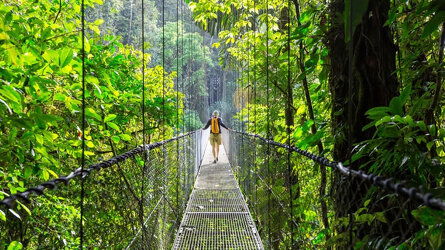
Launching in 1981, Explore offer trips from over 130 countries - from classic small group tours. Read more
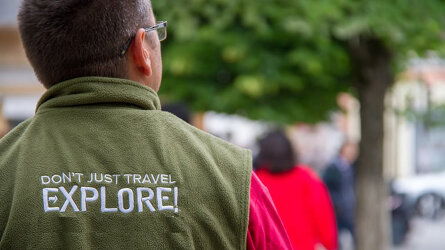
Explore's leaders are more than just your typical guide. They're your local expert are are passionate about sharing their expertise with you. Read more
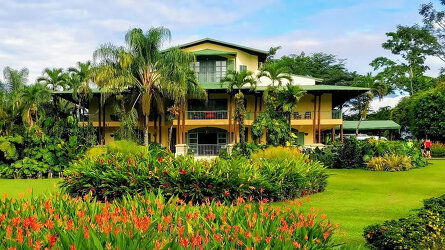
The places Explore stay are every bit as important as the sights they visit and the things you do. Read more

Launching in 1981, Explore offer trips from over 130 countries - from classic small group tours. Read more

Explore's leaders are more than just your typical guide. They're your local expert are are passionate about sharing their expertise with you. Read more

The places Explore stay are every bit as important as the sights they visit and the things you do. Read more
Brochure

Explore Small Group Adventures (2024-25)
Brochure

Explore Small Group Adventures (2024-25)
Availability
A definite departure means minimum numbers have been reached for this departure to operate. Your Global Journeys Travel Advisor will check the availability of your departure date when you enquire. Additional savings may apply. We guarantee the lowest price in Australia. T&C’s apply.
Tour & cruises prices are per person. Prices shown have savings applied, are subject to availability and may be withdrawn at any time without notice. Prices and trip information are correct at the time at this point in time, however are subject to confirmation at the time of booking and are subject to change by Explore. For cruise itineraries, cabin images are sourced from Explore. These should be treated as indicative only. Cabin inclusions, upholsteries and room layout may differ to the image(s) shown depending on the ship selected and your sailing dates.
